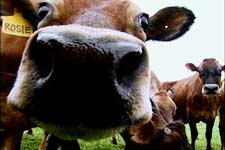This is the director’s cut version, a story about Jon Bansen, a 3rd generation Oregon dairy farmer who switched from conventional to organic dairy farming in 2000. The Double J Jersey 450 acre farm is located about 20 miles west of Salem.
Originally, this story was divided into two parts, his roots in agriculture as a 3rd generation dairy farmer (Organic Dairyman: A Family Tradition), and his life after converting to an organic practice (Organic Dairyman: The Farmer). More than just the combining of both parts into one, it also contains a new open, and the pacing throughout is more consistent with the slow pace of his natural environment.
It’s impossible to have a conversation with Jon Bansen without asking about his favorite cow Rosie. She’s now 12 years old (she was 9 in the film), and for an active producing cow, well beyond the average productive years for a dairy cow. And yet, Bansen proudly shares, Rosie is producing 120% of capacity compared with the rest of his 165 jersey cow herd. By contrast, Bansen explains, the average conventional dairy cow will last about 4 years, and during their first two years, will not produce any milk at all. To Bansen, organic cows are healthier, and remain on average, productive longer, than their conventional counterparts because of the differences in how they are treated, and their access to open pasture for grazing.
Organic milk offers additional advantages to consumers in the form of higher nutrient levels, such as Omega 3 fatty acids; better taste (I’ll personally vouch for this one); and is free of antibiotics, and growth promoting hormones. In conventional dairy operations, cows often do not have access to pasture for grazing, instead they spend much of their lives in confinement lots, and are fed conventional feed that according to Bansen is both unnatural, and stressful to their stomachs, and to their overall lives.
Just recently, the USDA enacted tougher requirements for organic livestock practices, to ensure that animals receive a considerable amount of their food from pasture grass, and lead more natural lives, without undue confinement. Organic agriculture, and by extension, organic livestock management embraces a holistic view of farming that seeks to work with nature, not against it. The new access to pasture requirements will likely effect more organic dairy operations in the West and Southwest where larger herd sizes (300+ cows) will no longer be economically viable due to the amount of grazing land needed . The majority of organic dairy farms are located in the Northeast and Midwest, and contain much smaller herd sizes.
From the USDA site, these are the main components of the new rule:
- Animals must graze pasture during the grazing season, which must be at least 120 days per year;
- Animals must obtain a minimum of 30 percent dry matter intake from grazing pasture during the grazing season;
- Producers must have a pasture management plan and manage pasture as a crop to meet the feed requirements for the grazing animals and to protect soil and water quality; and,
- Livestock are exempt from the 30 percent dry matter intake requirements during the finish feeding period, not to exceed 120 days. Livestock must have access to pasture during the finishing phase.
For organic dairyman, Jon Bansen, the consistent health of his Jersey cows, their added years of milk production, a sustainable approach to the ecosystem of his farm operations, and his continued economic well being as a member of the Organic Valley farmer owned co-op, despite the recent economic meltdown, and a nationwide decline in organic milk production, he appears to be optimistic for the future of organic dairy farming.
Rosie too, says, moo!
Most of the videos featured on Cooking Up a Story were produced, filmed, and edited by Rebecca Gerendasy. Fred Gerendasy contributed as a writer to many of the posts and occasionally as the interviewer. Visit Rebecca Gerendasy Clay – Art and Fred Gerendasy Photography to see their current work.


